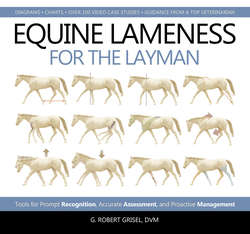Читать книгу Equine Lameness for the Layman - G. Robert Grisel DVM - Страница 11
На сайте Литреса книга снята с продажи.
C
ОглавлениеCaudal: Toward the tail. Refers to anatomy of the head and body parts above the carpi (knees) in the forelimbs and tarsi (hocks) in the hind limbs. “The pelvis is caudal to the neck.”
Centerline: An imaginary line that splits the horse into right and left halves (see also Midline).
Central Neurologic Lameness: Altered movement stemming from abnormal function of the brain and/or spinal column.
Cervicothoracic: The region adjoining the neck and chest.
Chronic: Of long or indefinite duration. “This horse has a chronic lameness; it first developed last year.”
Circumduction: The circular or conical movement of a limb relative to the horse’s body. During protraction, the circumducting limb moves away from the midline before moving back toward it, thus tracing a semicircle. This gait deficit is most often associated with neurologic disease in the horse.
Collagen Fibers: Small, inelastic reticular fibrils comprised of insoluble protein. Collagen fibers are found in skin, bone, ligaments, tendons, and cartilage, and comprise nearly one-third of all body protein.
Collateral: On either side. “The medial (inside) and lateral (outside) collateral ligaments of the fetlock joint function to maintain stability.”
Collection: A movement performed by the horse in which more weight is assumed by the hind limbs relative to the forelimbs.
Columnar: A pattern of muscle tissue in which individual fiber bundles (called fascicles) run parallel to the long axis of the structure and its respective tendon. This pattern allows for extensive range of motion but generates nominal force.
Compensating Limb: The limb that “takes the brunt” of the primary problem associated with another limb. “The horse’s left front limb often serves as the compensating limb for the right hind limb.”
Concentric Muscle Action: Contraction or shortening of muscle fibers.
Contraction: The process of becoming shorter or shrinking.
Contralateral: Located on the other side of the horse. “The right front limb is contralateral to the left front and left hind limbs.”
Contralateral Counterpart: The comparable limb located on the other side of the horse. “The right hind limb is the contralateral counterpart to the left hind limb.”
Contralateral Limb: A limb located on the other side of the horse. “The left front limb is contralateral to the right front and right hind limbs.”
Correct Lead: Leading with the inside forelimb while turning or circling.
Cranial: Toward the head. Refers to body parts above the carpi (knees) in the forelimbs and tarsi (hocks) in the hind limbs. “The neck is cranial to the pelvis.”
Cross-Firing: Striking the forelimb with the opposite (diagonal) hind foot. Occurs in pacers.
